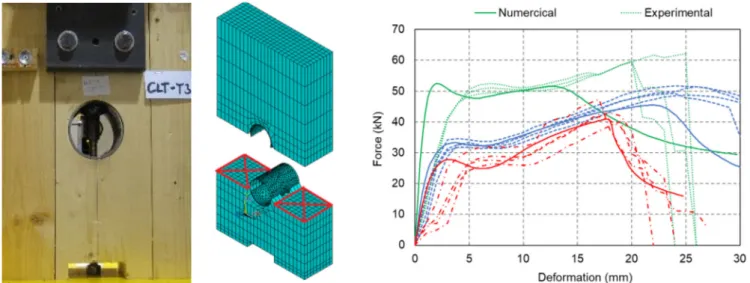ISBN: 978-91-88898-64-7
93
Numerical Optimization of Novel Connections for Cross-laminated Timber Buildings
Hercend Mpidi Bita†1, Cristiano Loss†2, and Thomas Tannert‡
†1 PhD candidate, Dept. of Wood Science, The University of British Columbia, hercend_mb@alumni.ubc.ca †1 Assistant Professor, Dept. of Wood Science, The University of British Columbia, cristinao.loss@ubc.ca ‡ Associate Professor, Wood Engineering, University of Northern British Columbia, thomas.tannert@unbc.ca
This paper presents Finite Element Analyses (FEA) on the performance of two types of novel hold-down connections, suitable for shearwalls of mass-timber buildings. The first hold-down consisted of hollow circular steel tubes, inserted in use in Cross-laminated Timber (CLT). The FEA models, which accounted for nonlinear material properties of both timber and steel components, were validated against experimental results [1]. The primary objective was to optimize the connector geometry and material properties to achieve a target yield capacity. Considering a capacity-based design approach, where all the wood components remain elastic and only the steel tube deformed, a sensitivity analysis was performed to quantify the input-performance correlations. It was shown that the diameter (d) and thickness (t) of the tube, as well as the coupler diameter (c) were the main parameters influencing the yield capacity and overall performance of the connection. The subsequent optimization resulted in an optimum geometry and provided specific material properties requirements, a load-carrying capacity of 100kN, an elastic stiffness of 30kN/mm, and a ductility of 9 was deemed obtained. Thereafter, a robustness analysis quantified the impacts of uncertainties in the material properties and geometry of the connection; it was shown that the optimized detailing exhibited a robust performance in the presence of uncertainties in the timber and steel material properties, as well as geometry [2]. The second hold-down consisted of a similar concept but replaced the circular steel tube with a rubber based material which provided the required strength and stiffness, but did not exhibit any plastic deformation.
Figure 1: Tube test specimen (left); FEA model (center); and load-deformation curves (right)
References
[1] J. Schneider, T. Tannert, S. Tesfamariam, S.F. Stiemer: Experimental assessment of a novel steel tube connection in cross-laminated timber. Engineering Structures, 177 (2018), 283-290.
[2] H. Mpidi Bita, T. Tannert: Numerical optimisation of novel connection for cross-laminated timber buildings.
